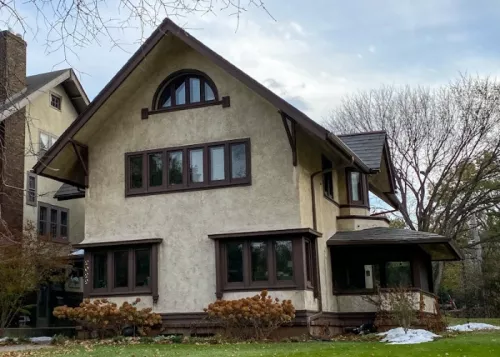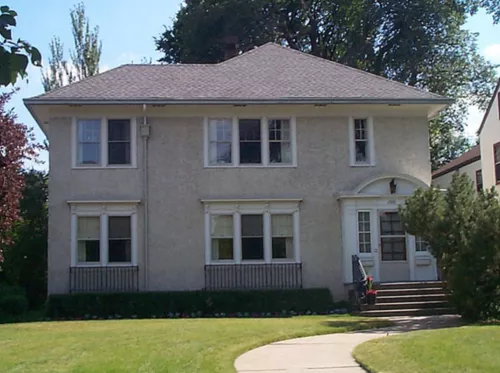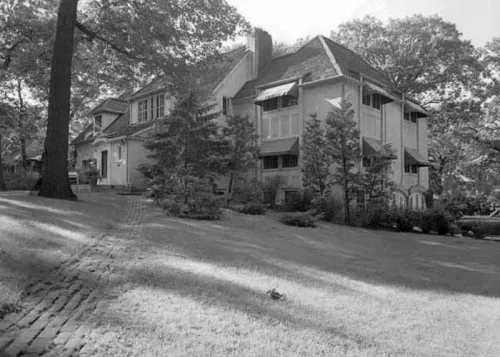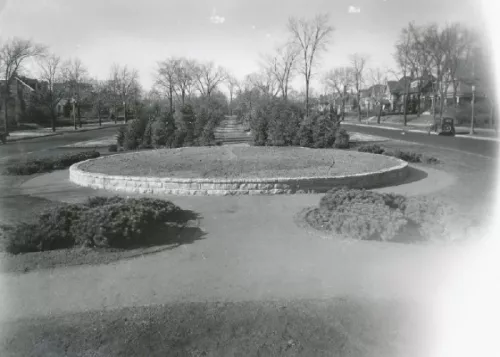Share what you know,
and discover more.
Share what you know,
and discover more.
Nov 02, 2020

2022 Summit Avenue; Dr. Ward Beebe House
A little different from many of the homes in the area, this three-story stucco house (aka Dr. Ward Beebe House) at 2022 Summit Avenue is a prairie-style home and listed on the National Register of Historic Places.
Nov 02, 2020
2022 Summit Avenue; Dr. Ward Beebe House
A little different from many of the homes in the area, this three-story stucco house (aka Dr. Ward Beebe House) at 2022 Summit Avenue is a prairie-style home and listed on the National Register of Historic Places.Posted Date
Jan 09, 2022
Historical Record Date
Nov 02, 2020
Source Name
kmfiswriting.com
Delete Story
Are you sure you want to delete this story?
Mar 10, 1977
Mar 10, 1977

-

- Dave D
2022 Summit Avenue, Saint Paul, MN, USA
Description: The Ward Beebe House is situated on a narrow, wooded lot at the intersection of the southern terminus of Wilder Street with Summit Avenue in St, Paul. Constructed in 1912 according to designs of Minneapolis architects Purcell, Feick, and Elmslie, this small residence is a well-preserved example of the Prairie School mode popularized by Frank Lloyd Wright. It is two storeys in height, capped by a deeply sweeping gabled roof. The entire wall surfaces are sheathed in pigmented stucco; the roof is of creosote-treated shingles. Window and door surrounds and casements are of both oak and cypress which is oiled and stained dark. The Summit Avenue facade (north) is incorporated within the gable. The entry is located within a small "el" which also houses the staircase. An incised panel with organic motif is affixed to the corner of the "el" immediately to the right of the doorway. Windows on this facade are arranged in horizontal bands of narrow, vertical casements. Those on the first storey are shielded by diminutive cornices and wrap around each corner to create an unbroken perspective view from within. The windows on the second storey are centrally placed within the facade and comprise a band of six narrow casements. A semi-circular arched window marks the third (or attic) level. The west facade is essentially symmetrical in arrangement with a three-part window grouping incorporated within a small gable at the second level; the center window of this grouping is an oriel which opens onto a small balcony. The first storey has a low open porch with a broad-eaved roof. To the rear (south) is an attached garage with space for two automobiles. A small sleeping porch at the second storey opens from the master bedroom. The interior of the Beebe House is simple in plan and decor; although typical of Prairie School taste. A large fireplace/chimney mass constitutes the central element in the plan. Entry is made through a low vestibule to the right of which a short flight of stairs leads into the living room. This room comprises the entire length of the north facade. The east wall of the living room is devoted to bookcases and built-in radiator cabinets; all woodwork is of dark-stained quartersawn oak. The fireplace/chimney is of sienna-colored roman brick laid with three eighths-inch mortar joints. The hearth and trim around the built-in flower box between the living room and dining room is of buff-colored stone. This feature provides an unobstructed view from the living room into the dining room. Along the west wall is a bank of floor-length casement windows which open onto the porch. Also in the dining room is a massive sideboard of oak which is finished in a similar fashion to the bookcases and other woodwork in the living room. A small kitchen is also located on the first floor and is linked to the dining room via a pantry. Cabinets in kitchen and pantry are also of oak, however, these have been painted. The second floor contains three bedrooms and a bathroom. The master bedroom is arranged as a suite with bed-chamber, dressing room and sleeping porch. There is also a bedroom and general-purpose room on the attic level. The Dr. Ward Beebe House remains in an excellent state of maintenance and preservation. The only alteration to the original design integrity has been the removal of several light fixtures and scones in the living room, this done by the present owners. (notes – “I doubt that garage is original, 5/10/1977” Significance: The house designed for Dr, Ward Beebe of St. Paul in 1912 by the architectural firm of Purcell and Elmslie and built at 2022 Summit Avenue is an example of the "Prairie School" style of architecture and expresses the influence of the Sullivan-Wright tradition of architecture. Purcell and Elmslie were pioneers of the modern movement in architecture. George G. Elmslie worked for the noted Chicago architect, Louis Sullivan, from 1893 to 1909. William Gray Purcell, who had grown up near Frank Lloyd Wright in a Chicago suburb, worked in Sullivan's Chicago office during 1903. The two Tiw>n formed a partnership in 1909 and established an office in Minneapolis. Elmslie's strength was his imaginative floor plans; Purcell's, the relationship of structure to site. The house they designed for Ward Beebe is one of several houses they built in Minneapolis and St. Paul and is typical of their endeavors in domestic architecture, the designing of inexpensive homes for ordinary people. An excellent example of their original work, the house has not been outmoded by changes in fashion or in building technology and represents one of the early functional solutions to the problems of housing.
2022 Summit Avenue, Saint Paul, MN, USA
Description: The Ward Beebe House is situated on a narrow, wooded lot at the intersection of the southern terminus of Wilder Street with Summit Avenue in St, Paul. Constructed in 1912 according to designs of Minneapolis architects Purcell, Feick, and Elmslie, this small residence is a well-preserved example of the Prairie School mode popularized by Frank Lloyd Wright. It is two storeys in height, capped by a deeply sweeping gabled roof. The entire wall surfaces are sheathed in pigmented stucco; the roof is of creosote-treated shingles. Window and door surrounds and casements are of both oak and cypress which is oiled and stained dark. The Summit Avenue facade (north) is incorporated within the gable. The entry is located within a small "el" which also houses the staircase. An incised panel with organic motif is affixed to the corner of the "el" immediately to the right of the doorway. Windows on this facade are arranged in horizontal bands of narrow, vertical casements. Those on the first storey are shielded by diminutive cornices and wrap around each corner to create an unbroken perspective view from within. The windows on the second storey are centrally placed within the facade and comprise a band of six narrow casements. A semi-circular arched window marks the third (or attic) level. The west facade is essentially symmetrical in arrangement with a three-part window grouping incorporated within a small gable at the second level; the center window of this grouping is an oriel which opens onto a small balcony. The first storey has a low open porch with a broad-eaved roof. To the rear (south) is an attached garage with space for two automobiles. A small sleeping porch at the second storey opens from the master bedroom. The interior of the Beebe House is simple in plan and decor; although typical of Prairie School taste. A large fireplace/chimney mass constitutes the central element in the plan. Entry is made through a low vestibule to the right of which a short flight of stairs leads into the living room. This room comprises the entire length of the north facade. The east wall of the living room is devoted to bookcases and built-in radiator cabinets; all woodwork is of dark-stained quartersawn oak. The fireplace/chimney is of sienna-colored roman brick laid with three eighths-inch mortar joints. The hearth and trim around the built-in flower box between the living room and dining room is of buff-colored stone. This feature provides an unobstructed view from the living room into the dining room. Along the west wall is a bank of floor-length casement windows which open onto the porch. Also in the dining room is a massive sideboard of oak which is finished in a similar fashion to the bookcases and other woodwork in the living room. A small kitchen is also located on the first floor and is linked to the dining room via a pantry. Cabinets in kitchen and pantry are also of oak, however, these have been painted. The second floor contains three bedrooms and a bathroom. The master bedroom is arranged as a suite with bed-chamber, dressing room and sleeping porch. There is also a bedroom and general-purpose room on the attic level. The Dr. Ward Beebe House remains in an excellent state of maintenance and preservation. The only alteration to the original design integrity has been the removal of several light fixtures and scones in the living room, this done by the present owners. (notes – “I doubt that garage is original, 5/10/1977” Significance: The house designed for Dr, Ward Beebe of St. Paul in 1912 by the architectural firm of Purcell and Elmslie and built at 2022 Summit Avenue is an example of the "Prairie School" style of architecture and expresses the influence of the Sullivan-Wright tradition of architecture. Purcell and Elmslie were pioneers of the modern movement in architecture. George G. Elmslie worked for the noted Chicago architect, Louis Sullivan, from 1893 to 1909. William Gray Purcell, who had grown up near Frank Lloyd Wright in a Chicago suburb, worked in Sullivan's Chicago office during 1903. The two Tiw>n formed a partnership in 1909 and established an office in Minneapolis. Elmslie's strength was his imaginative floor plans; Purcell's, the relationship of structure to site. The house they designed for Ward Beebe is one of several houses they built in Minneapolis and St. Paul and is typical of their endeavors in domestic architecture, the designing of inexpensive homes for ordinary people. An excellent example of their original work, the house has not been outmoded by changes in fashion or in building technology and represents one of the early functional solutions to the problems of housing.
2022 Summit Avenue, Saint Paul, MN, USA
Description:The Ward Beebe House is situated on a narrow, wooded lot at the intersection of the southern terminus of Wilder Street with Summit Avenue in St, Paul. Constructed in 1912 according to designs of Minneapolis architects Purcell, Feick, and Elmslie, this small residence is a well-preserved example of the Prairie School mode popularized by Frank Lloyd Wright. It is two storeys in height, capped by a deeply sweeping gabled roof. The entire wall surfaces are sheathed in pigmented stucco; the roof is of creosote-treated shingles. Window and door surrounds and casements are of both oak and cypress which is oiled and stained dark.
The Summit Avenue facade (north) is incorporated within the gable. The entry is located within a small "el" which also houses the staircase. An incised panel with organic motif is affixed to the corner of the "el" immediately to the right of the doorway. Windows on this facade are arranged in horizontal bands of narrow, vertical casements. Those on the first storey are shielded by diminutive cornices and wrap around each corner to create an unbroken perspective view from within. The windows on the second storey are centrally placed within the facade and comprise a band of six narrow casements. A semi-circular arched window marks the third (or attic) level.
The west facade is essentially symmetrical in arrangement with a three-part window grouping incorporated within a small gable at the second level; the center window of this grouping is an oriel which opens onto a small balcony. The first storey has a low open porch with a broad-eaved roof. To the rear (south) is an attached garage with space for two automobiles. A small sleeping porch at the second storey opens from the master bedroom.
The interior of the Beebe House is simple in plan and decor; although typical of Prairie School taste. A large fireplace/chimney mass constitutes the central element in the plan. Entry is made through a low vestibule to the right of which a short flight of stairs leads into the living room. This room comprises the entire length of the north facade. The east wall of the living room is devoted to bookcases and built-in radiator cabinets; all woodwork is of dark-stained quartersawn oak. The fireplace/chimney is of sienna-colored roman brick laid with three eighths-inch mortar joints. The hearth and trim around the built-in flower box between the living room and dining room is of buff-colored stone. This feature provides an unobstructed view from the living room into the dining room. Along the west wall is a bank of floor-length casement windows which open onto the porch. Also in the dining room is a massive sideboard of oak which is finished in a similar fashion to the bookcases and other woodwork in the living room.
A small kitchen is also located on the first floor and is linked to the dining room via a pantry. Cabinets in kitchen and pantry are also of oak, however, these have been painted.
The second floor contains three bedrooms and a bathroom. The master bedroom is arranged as a suite with bed-chamber, dressing room and sleeping porch. There is also a bedroom and general-purpose room on the attic level.
The Dr. Ward Beebe House remains in an excellent state of maintenance and preservation. The only alteration to the original design integrity has been the removal of several light fixtures and scones in the living room, this done by the present owners. (notes – “I doubt that garage is original, 5/10/1977”
Significance:
The house designed for Dr, Ward Beebe of St. Paul in 1912 by the architectural firm of Purcell and Elmslie and built at 2022 Summit Avenue is an example of the "Prairie School" style of architecture and expresses the influence of the Sullivan-Wright tradition of architecture.
Purcell and Elmslie were pioneers of the modern movement in architecture. George G. Elmslie worked for the noted Chicago architect, Louis Sullivan, from 1893 to 1909. William Gray Purcell, who had grown up near Frank Lloyd Wright in a Chicago suburb, worked in Sullivan's Chicago office during 1903. The two Tiw>n formed a partnership in 1909 and established an office in Minneapolis.
Elmslie's strength was his imaginative floor plans; Purcell's, the relationship of structure to site. The house they designed for Ward Beebe is one of several houses they built in Minneapolis and St. Paul and is typical of their endeavors in domestic architecture, the designing of inexpensive homes for ordinary people. An excellent example of their original work, the house has not been outmoded by changes in fashion or in building technology and represents one of the early functional solutions to the problems of housing.
Posted Date
Jan 09, 2022
Historical Record Date
Mar 10, 1977
Source Name
United States Department of the Interior - National Park Service
Delete Story
Are you sure you want to delete this story?












